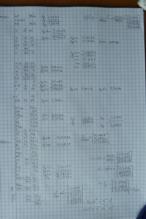
NavList:
A Community Devoted to the Preservation and Practice of Celestial Navigation and Other Methods of Traditional Wayfinding
Re: Aldebaran occultation
From: Brad Morris
Date: 2017 Mar 7, 11:55 -0500
From: Brad Morris
Date: 2017 Mar 7, 11:55 -0500
Lars
Alex notes his time of occultation at 3h56m48s.
Paul, using up to the minute tools, makes that "4 seconds earlier" at 3h56m44s.
Your reduction, using Wrangel's 100+ year old method, realized 3h56m53s. That is quite impressive, a delta of only 9 seconds or 2' of longitude! That certainly would be good enough to rate a chronometer on the ice!
Would you kindly comment more on the procedure and methodolgy? Is it lunars based?
You mentioned taking the sine of very small numbers which the logarithmic tables didn't cover. I note the log (sin (1'.74)) = 6.704. I worked that in reverse asin (10^(6.704-10)) by calculator to verify. Did you obtain this intermediate result by calculator or by a method available 100 years ago?
Brad
On Mar 6, 2017 10:30 AM, "Lars Bergman" <NoReply_Bergman@fer3.com> wrote:
I tried to obtain GMT from Alex's occultation. I assumed a longitude of 87°W and used GMT=4h as approximate time of the event. Then I followed the procedure shown in Wrangel's textbook on navigation, Stockholm 1910, slightly modified solving for SHA instead of right ascension. My favourite Burton's tables was not sufficient for log sine of very small angles, so I had to calculate those separately. Perhaps it was just good luck but the result is only a few seconds from that Alex noted.
I am not sure if my solution is correct, have the necessary precision everywhere, or use too many figures somewhere, nor have I done any sensitivity analysis. My attempt attached.
Lars
Attached File:







